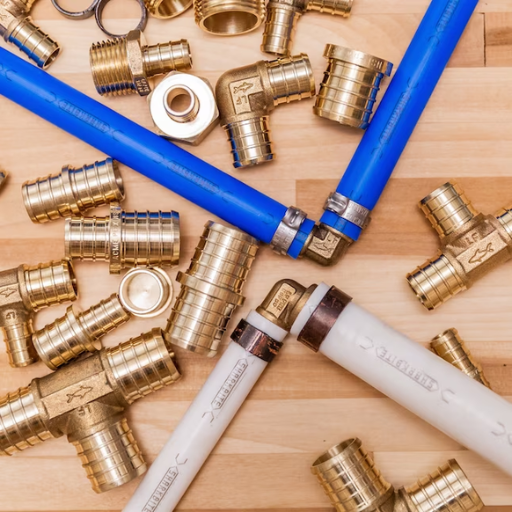In the plumbing sector, plumbers and DIY homeowners must know about different types of pipe fittings. This guide will discuss two of the most common PEX (cross-linked polyethylene) pipe systems: brass and crimp fittings. The continued popularity of PEX can be attributed to its flexibility, corrosion resistance, and ease of installation, hence the need for skills on how best to use these fittings. As we go through this article, we will look at the features, good side and wrong side of both brass and crimp fittings, giving you more than just an understanding of informed decisions on your plumbing project. Be it a new system or one that has had a facelift, this informative piece will provide you with the sound knowledge necessary for choosing fittings.
What Are PEX Pipe Fittings?
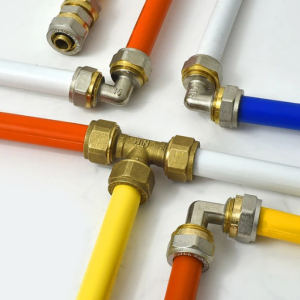
Image source: https://www.ifan-plast.com/
These are specialized connectors designed to join PEX pipes in plumbing systems. They are made from different materials, such as brass, polybutylene, or plastic, and have diverse shapes, such as elbows or tees. They should create secure connections that allow for flexible water supply lines and adaptability for any future changes. In general terms, by allowing quick and easy installations, they have been a preferred choice among experts and enthusiasts who feel comfortable working on their home’s plumbing needs.
Understanding PEX Tubing and Fittings
PEX tube is a cross-linked polyethylene flexible plastic pipe used for potable water plumbing in residential and commercial buildings. Its flexibility means that it can be easily bent around corners and through walls, eliminating the need for many fittings. Some of the advantages of using PEX include being free from chlorine and scale, lightweight, hence lower shipping cost, and able to withstand freezing temperatures without bursting.
PEX pipes, which were mentioned earlier, are significant when connecting PEX tubes. They come in different materials like brass, copper, or plastic and configurations like tees, elbows, or coupling fittings. The way they are installed depends on the type of fitting chosen. For instance, crimp fittings require special tools to ensure safe attachment of the fitting onto the pipe, while push-fit fittings enable a tool-less installation process. In general, PEX systems offer a reliable alternative to conventional plumbing supplies, making them popular among most contemporary plumbing projects.
Types of PEX Fittings: Brass, Plastic, and More
My experience with PEX fittings is that there are three main types: brass, plastic, and copper. Brass fittings are very hard-wearing and unreactive, ensuring a long life span; they can be best applied in various situations, but mainly where high pressure is involved. However, plastic fittings tend to be lightweight and straightforward to install; as such, they are not affected by corrosion or scaled deposits, so they are commonly used for most residential projects. On the other hand, copper fittings are seldom used because of their high cost and complicated installation methods, although they have good thermal conductivity. While each material has its advantages, I always think about the job’s specific needs when selecting appropriate PEX fittings.
The Role of Crimp Rings in PEX Plumbing
Crimp rings help keep PEX plumbing systems safe from any leaks. These metal rings are usually made from brass or stainless steel to hold PEX fittings onto pipes. To crimp means putting a ring on top of the tubing before inserting it into the fitting itself while squeezing them tightly with an appropriate tool until they both become one. With this process, you achieve leak-proof connections capable of withstanding high pressures and temperature fluctuations. Periodic inspection ensures these rings remain functional even after extended use since wear and tear or rust may affect them badly. Crimp rings win plaudits for their ease of installation and dependability, making them popular among plumbers.
How to Install PEX Fittings?
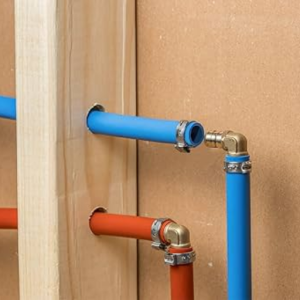
To install PEX fittings, straightforward methods only need some essential tools. Start by cutting the PEX pipe straight using a pipe cutter to ensure the edge is neat. After this, put a crimp ring on the tube, and then insert the PEX fitting into it until it reaches the shoulder of the fitting. Tighten the ring around the pipe and fit using a crimping tool to remove loose connections and prevent leaks. After compressing it with crimpers, ensure the correct size by applying a gauge (go/no-go). Finally, check every connection for proper setup and functioning. With time, one can install several PEX fittings quickly.
Step-by-Step Guide to Using a Crimp Tool
- Have your Materials: You should prepare your PEX Pipe, Crimp Rings, PEX Fittings, and Crimper.
- Cutting the PEX Pipe: Use a pipe cutter to obtain a clean, straight cut on your PEX pipe to avoid leaks.
- Slide On The Crimp Ring: Place your crimp ring over one end of our freshly cut pex pipes so that it stays about ¼ inches from its end.
- Put In The Fitting: Slide in our desired pex fitting until its head touches down at shoulder level, thus ensuring snugness.
- Set up the Crimp Tool: Open the crimping process tool and put the crimp ring into the machine’s jaws so that it falls in line with the designated section for crimping.
- Crimp the Ring: Apply pressure by squeezing hard on both handles of the crimper until it compresses around the fitting and pipe. Make sure it’s closed before proceeding.
- Check the Connection: Using the “go” or “no go” gauge, confirm that both ends of the crimps are secured well. A tight fit is needed to prevent leaks.
- Look at Again and Repeat: Check each joint to make sure there are no breaks, do this again for additional fittings, and evaluate every linked area that has been clamped.
These steps will ensure secure and dependable installation of your PEX fittings, leading to a successful plumbing job.
Connecting PEX Tubing with SharkBite Fittings
SharkBite fitting is a convenient alternative for many plumbing projects as it is simple and does not require special tools to connect PEX tubing, except that the pipes must be cut straight and clean, just like when crimp fittings are used. Consequently, I insert the SharkBite into the end of my PEX pipe until it hits the internal stop. In fact, by gripping the conduit automatically, this fitting only needs no crimp rings or clamps for tight connection. The user-friendly process can involve using a release tool to remove the fitting gently. Especially in small spaces, this methodology enables quick repairs or changes in my plumbing system.
Using PEX Elbows, Tees, and Couplings
Complex piping systems or any connections between multiple lines are best made using PEX elbows, tees, and couplings, which act as connectors. They allow 90-degree or 45-degree turns, making direction changes as easy as possible without requiring additional fittings. Tees are highly useful whenever branching one line into two separate pipes is desired; sinks and toilets can provide such fixtures. Couplings make simple connections between two pieces of PEX tubing, ensuring no leakage between them. Therefore, an important consideration when installing these fittings is to have PEX pipes that are correctly sized and cut properly, not to restrict flow but to prevent leaks. If you use a proper securing method such as crimping, clamping, or push-fit connections, your installation will last a long time.
What Are the Different Types of PEX Fittings Available?
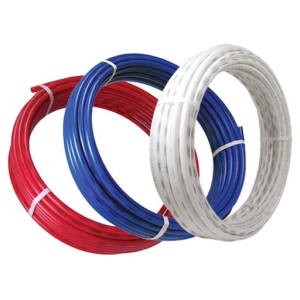
Different kinds of PEX fittings are made for specific applications in plumbing systems. These include:
- Crimp Fittings: A crimp ring and a specialized tool secure these fittings, making them watertight. They join PEX pipes mostly on a long-term basis.
- Push-Fit Fittings: These require no soldering, crimping, or special tools, making them easy for a layman to use. They are useful in quick repairs and adjustments.
- Barbed Fittings: To fasten the PEX onto a barbed end, you would need a clamp or a crimp ring. Sometimes, hose clamps are used to attach them securely.
- PEX-A, PEX-B, and PEX-C: These terms refer to different manufacturing techniques for making PEX tubes, which may require slightly different fittings depending on how flexible they are and how much they can expand
- Tees, Elbows, and Couplings: Tees help us branch off from the main pipe while elbows change the direction of the pipe. We also have couplings that connect two pipes together.
Knowing the types of PEX fittings could help you select the proper components for your plumbing projects, resulting in efficiency and reliability.
Overview of Brass PEX Fittings
As far as plumbing is concerned, brass PEX fittings rank highly due to their toughness and resilience. The corrosion-resistant properties of these materials ensure the protection of connections within plumbing systems for an extended period. Brass fittings work with all types of pex tubing, including hot and cold water systems. Moreover, brass fittings exist in many forms, such as elbows, tees, or couplings, thus providing dependable seals even under high-pressure conditions. Meanwhile, while some brands prefer using push-fit or crimp installation methods on their products, others find it more practical to design their goods to fit both techniques, enhancing their appeal across residential and commercial plumb lines. Moreover, they come in numerous aesthetic designs that attract visible plumbing joints, making them suitable for installation in any building.
Exploring PEX Expansion Fittings
Expansion fittings for PEX specifically allow cross-linked polyethylene (PEX) tubing to be added by expansion, an approach with numerous merits. Consequently, these fittings make installation more accessible and flexible since PEX pipes can be expanded over these fittings when pushed on them and then return to their previous sizes after sealing. In this way, the risk of joints leaking becomes minimal. It is good that expansion fittings are suitable for places where water temperature changes, leading to pipe expansion or contraction. Moreover, they are usually made from solid materials such as polymer or brass, which makes them able to withstand different conditions. For me, it’s essential to use proper expansion tools to achieve excellent results while using PEX expansion fittings so that I can have a dependable plumbing system.
Lead-Free vs. Standard Brass PEX Fittings
The decision between lead-free and standard brass PEX fittings should consider health and safety regulations and performance issues. Therefore, American drinking water legislation is adhered to by lead-free brass devices, which must contain not more than 0.25% lead for safe drinking purposes. Standard brass ones may have durability and reliability features, but they might not meet such legislations, which lay some potential health risks. Besides, they give equal resistance towards corrosion compared with standard brass fittings due to their similar strength plus temperature tolerances, identical to those of the last mentioned ones. Thus, for projects involving potable water, it is recommended that one chooses lead-free fittings because safety will not be compromised while ensuring performance also remains at its best level.
How to Choose the Right PEX Fitting?
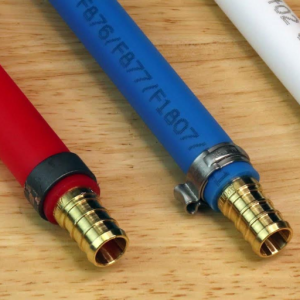
Several important factors should be considered when choosing the right PEX fittings. First, you need to determine what type of PEX tubing you have – cross-linked polyethylene (PEX-a, PEX-b, or PEX-c) – as it might influence fitting compatibility. Secondly, establish if it’s for potable water lines or radiant heating among other applications, this will help in selecting fittings that meet required standards. Furthermore, choose whether crimp, clamp, or expansion fittings are better depending on your installation method and available tools. Finally, any fittings used in drinking water systems should be lead-free whenever possible to comply with safety regulations. Assessing these issues will allow you to make an appropriate choice of a PEX fitting for plumbing purposes.
Factors to Consider: Size, Material, and Application
There are several primary considerations to consider when choosing your PEX fittings. First and foremost is the size as these need to match your PEX tube diameter to ensure proper flow and prevent leakage. The material is also essential; though most commonly made from brass polymer or stainless steel, they all have pros and cons regarding durability, price range, and suitability for different pipe systems, respectively. Finally, it is vital to consider the plumbing project’s purpose since those designed for hot water may require materials different from those for cold water or radiant heating purposes. Knowing such aspects ensures that an installation is successfully compliant with legislation.
Comparing Stainless Steel Clamps and Copper Crimp Rings
Based on my experience, the choice of stainless-steel clamps or copper crimp rings is often determined by individual project requirements and personal preferences. Stainless steel clamps are famous for their higher levels of resistance to corrosion and their strength qualities, making them suitable for high-pressure systems and environments with moisture problems. Additionally, it gives some room for maneuverability during installation since the clamp can be adjusted slightly. On the other hand, copper crimp rings are less costly in most cases and, when adequately crimped, offer a secure permanent seal. However, they might not be suitable for places with high humidity levels since corroding may occur over time. Consequently, I discovered that examining special conditions of plumbing systems together with financial considerations helps me choose the best option for my projects.
Why Choose Lead-Free Brass for Your PEX Plumbing?
Today, lead-free brass has become a standard material used in PEX plumbing systems because it is safe and dependable. First, this prevents water from becoming contaminated with lead, meeting more stringent regulations to reduce lead exposure through drinking water supply. Equally important, lead-free brass fittings have good durability properties and are resistant to corrosion, thus extending their lives as part of a plumbing system. Moreover, they possess solid and leak-proof connections, proving beneficial for residential and commercial purposes. By choosing these fittings, you will also enjoy their versatility since they can be used with different types of piping materials, leading to increased efficiency in plumbers’ work generally. Thereby favoring health & safety while investing in a solid and reliable plumbing solution that will last long, which means choosing lead-free brass pipes.
What Tools Are Needed for PEX Plumbing?
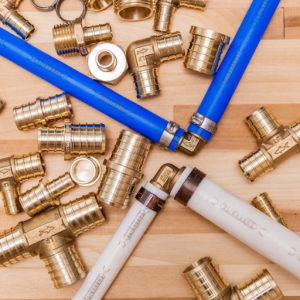
Some essential tools are needed for those who want to work with PEX plumbing effectively. Firstly, a PEX cutter is required to clean and precise the tubing. In addition, a crimping tool must be needed to secure fittings to pipes with crimp rings for tight connections. Those who prefer clamp rings should use a clamp tool instead. After cutting, one should smoothen out the edges using a pipe deburring tool to prevent harm to the fittings. A measuring tape will help you measure and plan your layout accordingly. Lastly, having a marker and screwdriver is enough to complete your toolkit by marking cuts on the job and installing any fixtures, respectively. Have these tools and be confident about handling anything related to PEX plumbing projects.
Essential Tools: Crimp Tool, Clamp Tool, and More
Whenever working with PEX plumbing systems, it is necessary to ensure that you have the appropriate tools to facilitate the installation process of this system efficiently. These include:
- Crimp Tool: This instrument is supposed to fasten the crimp rings on both PEX tubing and fittings, creating a watertight seal that is critical for the proper functioning of water systems.
- Clamp Tool: This equipment has been designed to firmly fix clamps around tubes during installation that use clamp rings rather than crimp rings.
- PEX Cutter: For effective fitting with no leaks, use an accurate cutter made specifically for PEX material, which allows clean cuts.
- Pipe Deburring Tool: It ensures smooth inner surfaces after cutting through PEX, thereby preventing damage to seals on fitments.
- Measuring Tape and Marker: Use them to get accurate lengths of tube sections and locations where fittings or cuts will be made.
- Screwdriver: It helps one connect fittings properly when tightening various fixtures
These are indispensable tools for anyone considering doing PEX plumbing jobs efficiently enough.
How to Use a PEX Crimp Tool Effectively
There are just a few simple steps that I would put in place to use the PEX crimp tool effectively. The tubing’s end is then cut cleanly and straight. For this to take place, a tight seal will be established. Afterward, I slid a crimp ring onto the tubing about an inch from the end of it. Then, he holds the fitting inside his tube to check if it is properly inserted. The handles are squeezed together firmly while ensuring I hear a click so that I know my crimping has been done correctly only after placing the crimping tool around the crimp ring with everything aligned. Finally, he checks out his crimps and determines whether any voids are present.
Maintaining Your PEX Plumbing Tools
I must do several important things to keep my PEX tools functioning well. Every time after use, it’s necessary to ensure each tool is thoroughly washed; this helps prevent any debris build-up or residue. To wipe my tools down, I usually employ a moist cloth that ensures no moisture remains on metal parts and thus prevents rust from occurring in those areas. As far as this particular device is concerned, one should continuously check for deterioration of its components and instantly replace any worn-out ones not to impede its workability. They should also be stored so that they do not get wet and remain ready for future jobs, which are easily accessible all the time. These practices help me extend the life of my tools for all PEX plumbing tasks that everyone can rely on over time, guaranteeing efficient performance.
Common Problems and Solutions in PEX Plumbing
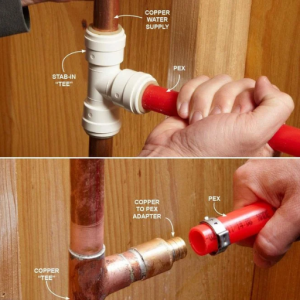
In PEX plumbing, several common problems can emerge. One such problem is frequently encountered: leaking connections. While incorrect crimping or damaged fittings usually account for this, you should monitor to ensure that the crimping is adequate and the fittings are unbroken; otherwise, cut out a section of the leaky pipe and connect it back properly.
More so, PEX tubes expand with temperature variations, thus putting stress on these fixtures. It is advisable to ensure proper support and the presence of spacers for movement.
Moreover, PEX may be affected by UV light, which weakens the tubing. Consequently, keep it away from direct sunlight, expunge any presence of ultraviolet rays during installation unless necessary, and consider replacing visibly discolored sections in the system to maintain its integrity.
Last but not least, your pipes could have kinks that restrict water flow. You can fix a kink by warming it slightly using a heat gun when you come across one. In severe cases, replace the piping segment where a kink occurs in the water flow. By troubleshooting them effectively, though, these common concerns help you maintain an efficient and reliable pex plumbing system.
Dealing with Leaks in PEX Pipe Fittings
The first step when dealing with leaks in PEX pipe fittings is to identify the source of the leak, which is usually a result of poor installation or damaged components.
- Crimping: This means ensuring all crimp rings are correctly installed and secured, avoiding fixing issues with a specially designed PEX crimping tool.
- Fittings: Existing fittings can be examined for any obvious signs of wear or damage, though compromises in fittings should be replaced rather than just repaired to avoid future leaks.
- Temperature Sensitivity: Awareness of extreme temperature variations that cause PEX expansion and contraction may lead to leakage. A pressure relief valve can mitigate this problem.
- Compatibility between Fittings and Pipes: The pipes used should have compatible fixtures. Using an incorrect type of fitting can heighten the risks associated with potential leaks.
When leakage persists, it is better to disconnect the connection, inspect and clean all components carefully, and then reassemble the joint with new materials to create an effective seal.
Repairing Damaged PEX Tubing
When I find spoiled PEX tubing, I adopt an orderly method to ensure a successful fixing. The first step involves isolating the damaged section by shutting off the water supply and releasing any pressure in the tubes. Secondly, I examine it; if it’s only a tiny puncture or cut, an intact tube can be connected using a PEX repair coupling. For more extensive damage, however, I often prefer cutting out the broken part and replacing it with a new one made of PEX material. To have a secure joint, I always ensure that proper connectors and crimping tools are used, and as soon as my water supply is back to normal, I check for any leaks again. By being organized and careful at all times, damaged PEX tubes can be repaired effectively, thereby maintaining an efficient plumbing system.
Preventing Common Installation Errors
The following key practices derived from reputable sources will help prevent common installation blunders when working with PEX tubing:
- Accurate Measurement and Cutting: Precision measurement is essential. Always measure twice before cutting so the pieces fit together seamlessly, thus eliminating waste or misalignment.
- Use the Right Tools: For instance, appropriate tools, such as cutters specifically designed for PEX systems, will guarantee effective performance during installation. People who use inappropriate tools risk making wrong connections, which may result in leaking.
- Observe Manufacturer Instructions: It is good to follow what your manufacturer says about its products in its manual regarding Pex lines during installations because different systems come with different specifications, such as the type of fittings and connectors, which might greatly affect their strength or how well they work.
By implementing these best practices, you can improve the reliability of your pex plumbing system while reducing the chances of installation issues.
Reference sources
- How to Choose the Right Pex Fitting – BoshartU
- Types of PEX Fittings – A Complete Guide of All PEX Fittings
- How to install PEX tubing – making a crimp connection
Frequently Asked Questions (FAQs)
Q: What are the different types of PEX pipe fittings?
A: There are several PEX pipe fittings, including PEX crimp fittings, PEX clamp fittings, and PEX expansion fittings. Each type has its unique installation method and is used in various plumbing applications.
Q: Are brass PEX fittings lead-free?
A: Many brass PEX fittings are lead-free, ensuring they meet safety standards for potable water systems. Always check the product specifications to confirm whether the fittings are lead free brass.
Q: How do I install PEX crimp fittings?
A: To install PEX crimp fittings, you need a crimp tool, a PEX crimp ring, and the appropriate fittings. Slide the crimp ring over the pipe, insert the fitting, and use the crimp tool to secure the ring.
Q: What is the difference between PEX crimp and PEX clamp fittings?
A: PEX crimp fittings use copper or stainless steel rings compressed with a crimping tool, while PEX clamp fittings use stainless steel clamps cinched with a special tool. Both methods create a secure connection for PEX tubing.
Q: Can I use PEX fittings with PEX A tubing?
A: Yes, PEX fittings can be used with PEX A tubing. PEX A tubing is known for its flexibility and durability, and it works well with various types of fittings, including PEX A expansion fittings.
Q: What is a PEX tee, and where is it used?
A: A PEX tee is a fitting that allows you to create a three-way connection with PEX tubing. It is commonly used in plumbing systems to split or combine water lines.
Q: How do I install a stainless steel PEX clamp?
A: To install a stainless steel PEX clamp, slide the clamp over the PEX tubing, insert the fitting, and use a PEX clamp tool to cinch the clamp securely around the tubing and fitting.
Q: What are the benefits of using lead-free brass fittings for PEX tubing?
A: Lead-free brass fittings are safe for use in potable water systems, resistant to corrosion, and durable. They provide a reliable connection for PEX tubing and help ensure the safety and quality of drinking water.
Q: What PEX pipes and fittings are available for plumbing applications?
A: PEX pipe and fittings come in various types, including crimp, clamp, and expansion fittings. Popular PEX pipe types include PEX A, B, and C, each with different characteristics suited for specific plumbing applications.
Q: How do I connect PEX tubing to a female pipe thread fitting?
A: Use a PEX adapter fitting to connect PEX tubing to a female pipe thread fitting. Insert the PEX barb end into the tubing, secure it with a crimp ring or clamp, and thread the other end into the female pipe thread fitting.



